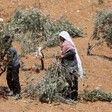Rights and Accountability 19 May 2024

Palestinians participate in a sit-in protest at Al-Aqsa Martyrs Hospital in Deir Al-Balah, on 5 May. They denounced the assassination of Dr. Adnan Al-Barash in an Israeli prison.
APA imagesTorture, amputations and the fetid smell of untreated wounds hang heavy in the air at the Sde Teiman facility.
An army base situated between Beersheba and Gaza in the southern Negev region, it was turned into a detention center for Palestinians, including abductees from Gaza, before they are transferred to other prisons.
Three Israelis who worked at the facility, and possibly participated in abuses against Palestinians, gave testimonies and pictures to CNN of what they witnessed.
The whistleblowers painted a grim picture of what amounts to a torture camp, where Palestinians are held without charge, interrogated and filtered through to detention centers or sent back to Gaza.
The facility is segregated into two areas: one designated for the detention of 70 Palestinians from Gaza, where they are subjected to severe physical restraint, CNN reported.
The other section serves as a so-called field hospital, where injured detainees are immobilized and strapped to their beds, forced to defecate in their diapers and fed through straws.
At least three army bases have been transformed into detention facilities since Israel’s genocide in Gaza began on 7 October, at least so far as the Israeli military has admitted to: Sde Teiman in Israel, and the Anatot and Ofer military bases in the occupied West Bank.
The number of Palestinians detained at those facilities is unknown.
During its ground invasion, the Israeli army converted schools within the Gaza Strip into military bases and detention centers, according to the group Euro-Med Human Rights Monitor.
One notable example is the Salah al-Din preparatory school in Gaza City. That school was transformed by Israeli occupation forces into a detention and interrogation center for hundreds of Palestinians in February.
Recent legal amendments have paved the way for such facilities, notably the “unlawful combatant law,” which expands Israeli authorities’ powers to detain Palestinians without charge, trial, seeing a judge or legal oversight for up to 75 days after arrest.
Detainees may also be deprived of legal counsel for up to six months.
“Unlawful combatants” have previously included individuals such as an elderly Palestinian woman with Alzheimer’s.
Formerly detained Palestinians at Sde Teiman have also described the harrowing conditions inflicted by Israeli authorities.
Pictures leaked to CNN depict rows of prisoners handcuffed, blindfolded and held behind a fence under floodlights.
“The prisoners are subjected to collective beatings and abuse by soldiers, using profanities that prisoners are unable to repeat,” prisoners rights group Addameer reported.
“They are also forced to kneel on gravel or asphalt, spending their days with their hands bound and blindfolded, unable to speak to each other.”
Addameer said Israeli interrogators torture detainees and subject them to “dignity-stripping treatment,” including stress positions for hours as well as sleep deprivation.
UNRWA, the UN agency for Palestine refugees, has collected information from hundreds of Palestinians who were detained since the beginning of Israel’s ground operation in late October last year, The New York Times reported.
Israeli authorities subjected Palestinians – “men and women, children, older persons, persons with disabilities,” according to UNRWA – to ill-treatment throughout their detention, including sexual abuse and threats of sexual violence.
“Paradise for interns”
Abducted Palestinians in the prison camp are subjected to routine amputations due to severe cuff injuries, an Israeli field doctor who had worked at the camp revealed to the newspaper Haaretz last month.
Whistleblowers provided CNN with descriptions of the field hospital at the camp, and the broadcaster created a 3D video model illustrating these accounts. The illustration depicted detainees lying horizontally, nearly naked, wearing diapers, with their hands and feet tied down to beds.
The video depicted a tent with up to 20 detainees.
One of the whistleblowers, who worked as a medic at the detention center’s so-called field hospital, described it as a playground for unqualified medical personnel. He even admitted to lacking the appropriate training for the treatment he was asked to administer.
“It is a paradise for interns because it’s like you do whatever you want,” he said.
“I was asked to learn how to do things on the patients, performing minor medical procedures that are totally outside my expertise,” he added.
“Just being there felt like being complicit in abuse.”
The same whistleblower said he witnessed an amputation performed due to injuries sustained by handcuffing.
Israeli authorities ensured that the identities of unqualified personnel were shielded from any potential future investigations by abstaining from signing any medical documents. This confirmation aligns with a report published earlier this year by Israeli rights group Physicians for Human Rights-Israel.
Dr. Mohammed al-Ran, a Palestinian with Bosnian citizenship who headed the surgical unit at the Indonesian hospital in northern Gaza, described to CNN what he witnessed while he was held at the Sde Teiman prison camp.
After Israeli forces seized him in December at the al-Ahli hospital in Gaza City, al-Ran was stripped, blindfolded, handcuffed, and crowded into the back of a truck with other Palestinian detainees, many of whom were also barely clothed, before being transported to the facility.
During his 44-day detention in the facility, the doctor spent most of his time serving as an intermediary between the prisoners and the guards.
It was during this period, when he was no longer blindfolded, that he witnessed the worst of the atrocities.
“Part of my torture was being able to see how people were being tortured,” he told CNN.
“At first you couldn’t see. You couldn’t see the torture, the vengeance, the oppression,” he added.
“When they removed my blindfold, I could see the extent of the humiliation and abasement … I could see the extent to which they saw us not as human beings but as animals.”
Worse than death
“Addameer asserts that there is a reasonable basis to claim that the occupying forces are committing war crimes and crimes against humanity against prisoners from the Gaza Strip,” the prisoners group said.
This encompasses complicity by the government, judges, prison authorities, police and the military, thereby undermining the credibility of any self-examinations, when and if they occur.
In March, a revealing exposé by Haaretz disclosed that at least 27 Palestinians have died while in Israeli custody since 7 October. Only six have been identified, according to Addameer.
However, this figure could potentially be higher, given disturbing reports of Palestinians dying in detention.
For instance, news only broke weeks after Dr. Adnan al-Bursh, the 50-year-old head of orthopedics at Gaza City’s al-Shifa hospital, was killed in Ofer Prison in the West Bank on 19 April, according to the Palestinian Authority.
Many Palestinians in Gaza remain missing, whether being trapped beneath the rubble of buildings targeted by Israeli shelling in Gaza, or laid to rest without identification – whether through Palestinian efforts to honor the dead or within mass graves created by Israeli soldiers during ground invasions.
Some Palestinians may view those facilities as their last chance to locate their missing family members.
However, a former detainee asserts this is a fate worse than death.
As Dr. Mohammed al-Ran was being released, a fellow prisoner implored him to locate his family in Gaza and deliver them a message.
“He asked me to tell them that it is better for them to be martyrs,” al-Ran recounted to CNN.
“It is better for them to die than to be captured and held here.”




